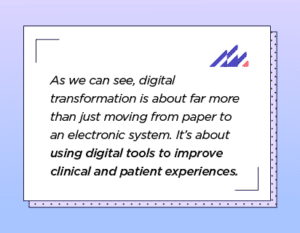Article
What does digital maturity look like?
Targets set out in the Digital Health and Social Care Plan reinforce that by 2025, integrated care systems (ICSs) should have met the minimum level of digital maturity as set out in the ‘What good looks like’ framework from NHS England. This includes a target for 90% of NHS trusts to adopt an electronic patient record system by December 2023 and 100% by March 2025. The latest research from NHS England shows there is still some way to go with only 20% currently at the level of digital maturity required by the March deadline.
These targets present both a challenge and an opportunity to many less digitally mature trusts that have been identified as part of NHS England’s Frontline Digitisation Programme. The Frontline Digitisation Programme shows the relative stage at which health providers across the country are on their digital maturity journeys. Whilst only an indicator, the various digital maturity groups highlight trusts that are excelling in digitisation and help stratify those at other stages of their digital maturity. For those procuring or in the early stages of deploying an EPR, this benchmarked data will help ensure their leaders have evidence to support investment decisions.

Typically, the path to digital maturity has been measured by the HIMSS Electronic Medical Record Adoption Model (EMRAM). This measures clinical outcomes, patient engagement and clinician use of EPR technology to strengthen organisational performance and health outcomes across patient populations.
The HIMSS EMRAM model suggests linear relationship between functional delivery and HIMSS EMRAM stage achievement. The reality is not so straight forward. The journey to digital maturity as measured by HIMSS EMRAM is one of organisational transformation and the overall use of solutions provided, across the range of facilities and services. Some organisations may not score well if they have selected a different path of implementation that does not match the EMRAM stages. Achievement is also not limited to evidence of using these clinical systems, it also requires demonstration of IT governance, resilience, training, business continuity, cyber safety and bidirectional patient engagement tools.
As an example of this journey, in 2018, Gloucestershire Hospitals NHS Foundation Trust (GHFT) had the lowest digital maturity for a trust of its size and demographic that HIMSS had ever seen. However, the trust embraced use of the Altera Sunrise EPR blueprint and deployed Inpatient Nursing Documentation within five months and then extended this by rolling out eOBS, which was instrumental in support of their COVID-19 Incident Response. Mark Hutchinson, Chief Digital and Information Officer, talks widely about the trust’s journey of “eating the elephant one bite at a time” as the trust worked to increase its digital maturity. Our experience has proven that achieving the desire and expected level of digital maturity is undoubtedly a journey which is best approached incrementally, whilst part of a clear and robust strategy. This enables the phased introduction of functions, facilitating adoption and ensuring sufficient focus can be given to the business and clinical transformation required for continued success.
Advancing digital ambitions and improving patient flow
The deployment of Sunrise in GHFT’s emergency department has further advanced the trust’s clinically driven digital maturity. Since rolling out to its EDs, the trust has also gone live with clinical documentation for doctors and allied health professionals.
The rollout within ED was carefully managed as part of a phased approach, which enabled the trust to demonstrate continuous improvement and secure buy-in at the board level for the major transformational change, despite the challenging context of the pandemic.
The trust has also recently activated electronic prescribing and medication administration (ePMA) functionality in Sunrise. This is another major milestone for the trust, and further progress towards the goal of reaching HIMSS EMRAM Stage 6 by 2024.
 Mark Hutchinson said, “As we can see, digital transformation is about far more than just electrifying paper. It’s about using digital tools to improve clinical and patient experiences. The conversations we’ve been able to have about improving patient flow beyond the emergency department are encouraging and will be important as we continue our digital transformation journey and provide better patient care as a hospital trust and as part of the One Gloucestershire Integrated Care System.”
Mark Hutchinson said, “As we can see, digital transformation is about far more than just electrifying paper. It’s about using digital tools to improve clinical and patient experiences. The conversations we’ve been able to have about improving patient flow beyond the emergency department are encouraging and will be important as we continue our digital transformation journey and provide better patient care as a hospital trust and as part of the One Gloucestershire Integrated Care System.”
Providing clinical technologies and experience
Altera is well positioned to assist trusts in their digital maturity journey, providing the clinical technologies, experience and guidance needed to achieve this highest of standards. We have supported many organisations internationally in reaching Stage 6 and 7 and most recently within the UK Liverpool Heart and Chest Hospital achieved Stage 6 in December 2021 and are now aiming for HIMSS EMRAM Stage 7 status.
No matter where you are—whether embarking on the digital journey to implement an EPR or are an established user now looking to extend and optimise use of the features of our technologies—Altera Digital Health’s proven deployment methodology and experience can help you to quickly advance your digital maturity and future-proof the needs of your patients and clinicians.
To learn more about Altera, please click here.













